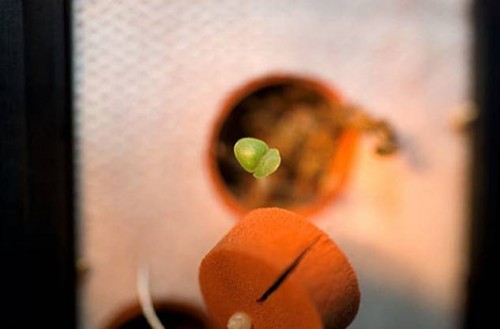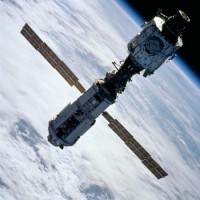Tag archives: International Space Station
Cress on the Moon, more physics books, a radioactive ‘foot’ and more

A small green sprout of cinnamon basil, growing on board the International Space Station in 2007. (Courtesy: NASA)
By Tushna Commissariat
Early this week, a story in the Telegraph caught our eye – NASA is planning on sending turnip, cress and basil seeds to the Moon to germinate them! This is most definitely not the first time that plants have been grown beyond the realms of Earth. Indeed, potatoes were grown on board during a 1995 Space Shuttle mission and many experiments involving germinating seeds were done on the International Space Station. The goal of these studies was to understand the effects of microgravity on plant growth. But now, NASA plans to take this one step further in 2015 with their Moon Express mission, which will include the Lunar Plant Growth Chamber that will carry seeds and enough air and nutrients to allow the seeds to sprout and grow. Will fresh salad be on an astronaut’s menu soon?
BBC radio celebrates 101 years of cosmic rays
By Hamish Johnston

AMS is a modern version version of Hess’s balloon experiments. (Courtesy: NASA)
The BBC’s Melvyn Bragg has lots to talk about. Over the past few months he has chatted about the Icelandic sagas, water, Gnosticism, and much more on his Radio 4 programme In Our Time. So he can be forgiven for missing a centenary and celebrating cosmic rays 101 years after they were discovered by the Austrian physicist Victor Hess.
View all posts by this author | View this author's profile
When will quantum communications blast off?

Will quantum communications be sent to the ISS? (Courtesy: NASA)
By Hamish Johnston
I think it’s safe to say that quantum communications between satellites and ground-based stations should be possible. Optical signals have already been sent 144 km through the air between ground stations at sea level. More recently, quantum communications have been achieved between an aircraft in flight and a ground station 20 km distant.
While quantum communications have been sent comparable distances via optical fibre, it’s unlikely that the fragile single photons used in such missives would survive an ocean crossing unscathed. Therefore if technologies such as quantum key distribution cryptography are to become truly practical, satellites must be involved.
First results due from AMS
By Michael Banks in Boston
The first results from the $1.5bn Alpha Magnetic Spectrometer (AMS) are expected to be released in the coming two weeks, according to AMS principal investigator Samuel Ting.
Ting, who shared the 1976 Nobel Prize for Physics, was speaking at the 2013 AAAS meeting in Boston.
View all posts by this author | View this author's profile
Atlantis lifts off into history
By Tushna Commissariat
Despite gloomy weather conditions that threatened to cancel the launch altogether, NASA’s shuttle Atlantis has launched from the Kennedy Space Center. Marking the last and final flight of the Space Shuttle Programme – STS-135 – Atlantis and a four-person crew are on a 12-day mission to deliver more than 3.5 tonnes of supplies to the International Space Station (ISS). This final stock should keep the station running for a year. Although the countdown stopped briefly at 31 s before the launch, the shuttle had a “flawless” lift-off, according to NASA. It has now settled down into its preliminary orbit ahead of its rendezvous with the ISS this Sunday morning.
The image above is of the shuttle, taken shortly after the rotating service structure was rolled back yesterday at Launch Pad 39A at the Kennedy Space Centre in Florida (Credit: NASA/Bill Ingalls). Below is an image of the mission patch for this final iconic flight (Credit: NASA).

“The shuttle’s always going to be a reflection of what a great nation can do when it commits to be bold and follow through,” said astronaut Chris Ferguson, commander of the mission, from the cockpit of Atlantis minutes before the launch. “We’re completing a chapter of a journey that will never end. Let’s light this fire one more time, and witness this great nation at its best.”
Atlantis was the fourth orbiter built and had its maiden voyage on 3 October 1985. Atlantis had a number of firsts to its name – it was the first shuttle to deploy a probe to another planet, to dock to the ISS and the first with a glass cockpit! It conducted a final servicing mission to the Hubble Space Telescope in May 2009.
NASA has decided to retire its shuttle programme with this last flight because the vehicles are too costly to maintain. It now intends to contract out space transport to private companies. The hope is that this will free NASA resources to invest in a other programmes that will potentially send humans beyond the space station to the Moon, Mars and maybe even asteroids.
Atlantis is also carrying some rather unusual passengers – some simple yeast cells. The aim is to study the yeast cells as their genetic make up is remarkably similar to that of a human cell. This makes it an ideal system for studying genetic defects and understanding how these defects may manifest in human disease. In two separate experiments – conducted at the ISS – researchers will study the effect of microgravity on cell growth.
The video below has the crew of Atlantis talking about the “vibrancy of the ISS as a stepping stone for NASA’s plans for future human exploration beyond low Earth orbit”.
View all posts by this author | View this author's profile
